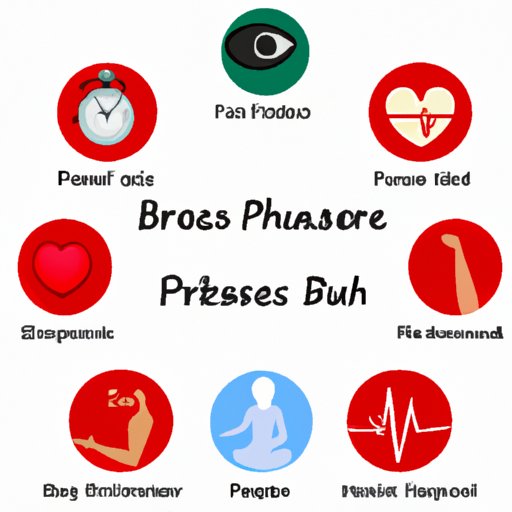Introduction
High blood pressure, or hypertension, affects nearly half of all Americans and can have serious health consequences if left unmanaged. However, there are several simple lifestyle changes that one can make to lower their blood pressure. In this article, we’ll cover the best foods to eat, the importance of exercise, meditation and yoga, and alternative therapies for blood pressure management.
5 Simple Lifestyle Changes to Lower Your Blood Pressure
There are several lifestyle changes you can make to help manage high blood pressure:
Dietary Modifications
Eating a well-balanced diet rich in whole foods and low in processed foods can be helpful in managing high blood pressure. Foods high in saturated and trans fats should be avoided, as should those with excessive sodium content. Instead, focus on foods that are high in fiber, protein, and healthy fats, such as vegetables, fruits, lean meats, and nuts.
Practical Tips: Swap out processed foods for whole foods whenever possible, read labels carefully to avoid excessive sodium, and consider working with a dietician to create a personalized meal plan.
Physical Activity
Regular exercise is essential for maintaining overall health and can be especially beneficial in lowering blood pressure. Aim to engage in moderate-intensity exercise for at least 30 minutes most days of the week.
Practical Tips: Choose activities that you enjoy, such as swimming or cycling, join a fitness group or class, and break up workouts throughout the day if necessary.
Stress Reduction
Stress can play a significant role in high blood pressure. Therefore, it is important to find ways to manage stress effectively. Techniques such as deep breathing, mindfulness, and meditation can be helpful in reducing stress levels.
Practical Tips: Practice mindfulness for 10-15 minutes each day, take time to relax and unwind, and consider seeing a therapist or counselor if stress levels remain high.
Weight Control
Those who are overweight or obese are at a much higher risk of high blood pressure. Therefore it is important to maintain a healthy weight.
Practical Tips: Keep track of your weight through regular check-ins, set realistic goals, and work with a healthcare professional to come up with a plan for weight loss if necessary.
Consult a Healthcare Professional
Before making any significant changes to your diet or exercise routine, consult with a healthcare professional.
Practical Tips: Discuss any medications you are currently taking and learn how they can impact your blood pressure. Create a health plan that is personalized to your needs and be sure to make any necessary changes under the guidance of a healthcare professional.
The Best Foods to Eat to Control Blood Pressure
While replacing processed foods with whole foods is essential in managing blood pressure, there are several foods that are particularly useful in this regard:
Leafy Greens
Leafy greens such as spinach, kale, and chard are high in potassium, a mineral that can help to balance out the negative effects of sodium on blood pressure.
Practical Tips: Make a salad with fresh spinach, add kale to a smoothie, or sauté chard as a side dish.
Berries
Berries such as blueberries and strawberries are high in flavonoids, a powerful antioxidant that can help to reduce inflammation and improve blood vessel function.
Practical Tips: Add berries to a smoothie, enjoy them as a snack, or add them to oatmeal or yogurt.
Lean Proteins
Lean proteins such as chicken, turkey, and fish are high in protein and low in saturated fat, making them an excellent choice for blood pressure management.
Practical Tips: Grill chicken or fish for a healthy and flavorful meal, top a salad with grilled chicken or shrimp, or add canned tuna to casseroles or salads.
Why Exercise is Crucial for Lowering Your Blood Pressure
The benefits of exercise go far beyond weight loss. Regular physical activity is an essential part of managing blood pressure and overall cardiovascular health.
According to the American Heart Association, regular exercise can help to:
- Reduce the risk of heart disease and stroke
- Lower blood pressure
- Improve cholesterol levels
- Maintain a healthy weight
- Reduce stress levels
Even small increases in physical activity can have significant health benefits. Aim to engage in moderate-intensity exercise for at least 30 minutes most days of the week.
Practical Tips: Try to incorporate exercise into your daily routine, such as taking a walk during lunch breaks or opting for the stairs instead of the elevator. Join a fitness group or class if necessary, or try a home workout video if preferred.
Meditation and Yoga: The Secret to Lowering Blood Pressure
Mind-body practices such as meditation and yoga can be helpful in managing blood pressure by reducing stress levels. By inducing a state of deep relaxation and calm, meditation and yoga can lower blood pressure and improve overall health and well-being.
Practical Tips: Consider attending a local yoga or meditation class, download a meditation app, or try following a yoga video on YouTube. Start with just a few minutes each day and gradually increase your practice.
Alternative Therapies for High Blood Pressure Management
In addition to traditional interventions such as medication and lifestyle changes, complementary therapies such as acupuncture, aromatherapy, and reflexology can be helpful in managing blood pressure.
While more research is needed to fully understand the effectiveness of each therapy, some potential benefits may include stress reduction, improved circulation, and enhanced relaxation.
Practical Tips: Discuss any alternative therapies with your healthcare provider before trying them out. Look for trained professionals and licensed practitioners in your area to ensure safety and effectiveness.
Conclusion
Managing blood pressure can be simple with lifestyle changes involving diet, exercise, meditation and yoga, and alternative therapies. By adopting these practices, you can improve your blood pressure and overall health and well-being. Don’t forget to consult with your healthcare provider before making any changes to your lifestyle or treatment plan.
